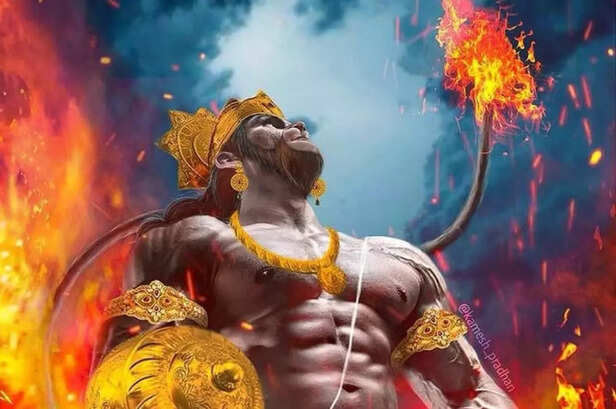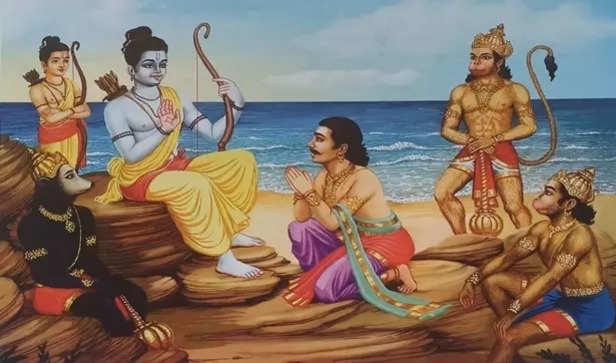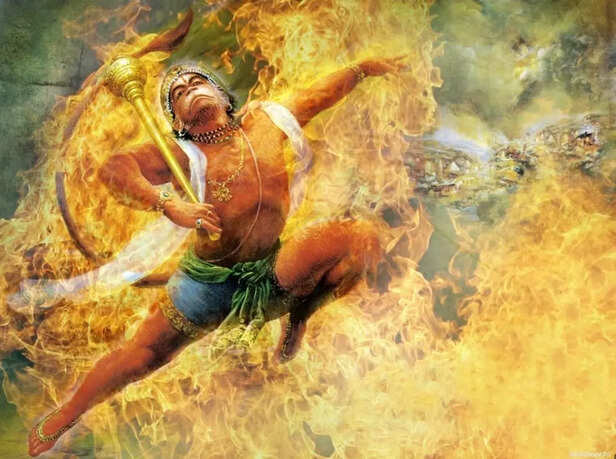Secret of the Horse-Faced Hanuman — The Destroyer of Negativity and Black Magic
Ankit Gupta | Apr 17, 2025, 12:40 IST
( Image credit : Timeslife )
There exists a form of Hanuman known only to the sincere spiritual seekers and rare Tantrics—one that is more fierce than even the renowned Panchmukhi Hanuman. This is the Vadvanal Hanuman, a form not commonly known, but supremely powerful in protecting against black magic, psychic attacks, planetary afflictions, and malignant spirits.
In the infinite cosmos of Hinduism, Hanuman radiates as a symbol of unmatched devotion, divine strength, and fearless protection. Among his many revered forms, the world knows him as the Panchamukhi Hanuman, the Sankat Mochan, and the servant of Shri Rama. However, in the depths of Tantric knowledge and esoteric scriptures lies a mysterious form, rarely mentioned and almost never depicted. This is the fierce, radiant, horse-faced Hanuman, known as Vadvanal Hanuman—a protector invoked only in times of extreme adversity, psychic danger, and spiritual warfare.
This article explores the mystical depths of this form, the cosmic fire known as Vadava Agni, the origins and power of the Hanuman Vadvanal Stotra, and how invoking this aspect of Hanuman can transform one’s life. In a world plagued by unseen energies, ancestral blocks, and spiritual pollution, Vadvanal Hanuman stands as the divine firewall—one who burns through darkness to make way for light.

Ancient Hindu cosmology speaks of a secret fire hidden beneath the oceans—a flame so intense that it defies natural law and burns even underwater. This is Vadava Agni, also called Vadavanala, the submarine fire. It is said to reside at the ocean’s floor and represents a metaphysical principle of contained yet potent energy. The term "Vadava" means a mare, and "Anala" means fire—symbolizing a horse-faced blaze of divine fury.
This fire is not destructive in the conventional sense. It is a cosmic force that maintains the balance of the universe, lying dormant until summoned to neutralize negativity and restore dharma. This very principle becomes manifest when Hanuman takes the form of Vadvanal—a blazing, horse-faced deity whose body is fire and whose breath ignites the cosmos.

The form of Vadvanal Hanuman is not found in common temple sculptures or Puranic recitals. It is mentioned in select Tantric texts and remembered in whispers among initiated practitioners. This form is not gentle or accessible—it is fierce, reserved for moments when the world is torn by psychic plagues and the soul is attacked by invisible forces.
Legends say that when Rama and Lakshmana once fell prey to powerful occult energies sent by dark forces during the war in Lanka, even the divine herbs of the Himalayas couldn’t fully restore them. At that moment, Hanuman transformed into Vadvanal—a searing divine flame in the shape of a horse-headed being. With his roar, he purified the battlefield and rendered demonic magic powerless.
His eyes blazed with solar fire, his mane burned like a thousand suns, and his hooves shattered the illusions of Maya. This was not just Hanuman—it was the cosmic purifier in action.

The Hanuman Vadvanal Stotra, one of the most potent mantras for protection and purification, emerged from the heart of desperation. Vibhishana, the noble brother of Ravana, was torn between blood and dharma. Abandoned by his family, threatened by demonic powers, and mocked for his righteousness, he fell into a state of deep spiritual and emotional agony.
In that state of surrender and anguish, he composed a stotra—not as an intellectual exercise but as a cry for divine rescue. He invoked Hanuman not as the sweet, compassionate Sankat Mochan but as the blazing, unstoppable Vadvanal. And the heavens responded.
Hanuman, pleased by the sincerity and urgency of Vibhishana’s call, appeared in his fiery form and neutralized the psychic attacks on him. Vibhishana later became the king of Lanka under Rama’s rule, symbolizing how invoking this form can completely reverse karmic destiny.
The Hanuman Vadvanal Stotra is unlike other devotional compositions. It is not merely praise—it is a command, an invocation, and a spiritual weapon. Every syllable is infused with bija mantras, tantric syllables, and cosmic metaphors that trigger transformation.
The Stotra seeks:
We live in an age of subtle poison. People may not throw spears, but they hurl envy. They may not chant curses aloud, but they emit negativity through thought and speech. The evil eye, unresolved karmic imprints, ancestral blocks, and spiritual pollution can derail even the most sincere efforts.
Symptoms of such psychic attacks often include:
In Tantric literature, much is said about the invisible threats to the human soul. Shakini and Dakini are astral feminine entities known to cause illness and mental imbalance when karmic weakness allows their entry. Pisachas are parasitic spirits that thrive in low-vibration environments—feeding on depression, lust, and fear.
When the aura is cracked through trauma or prolonged negative thinking, these entities attach and drain life force. The Vadvanal Stotra creates a fiery energy shield around the devotee. Unlike passive protection mantras, this stotra actively seeks and destroys such entities.
It doesn’t just remove them—it makes the inner environment so radiant and fiery that such beings cannot return.
While rooted in deep spiritual traditions, the Vadvanal Stotra also impacts the psychological and physical body. Mantras are sound vibrations, and sound affects matter. Regular chanting of the stotra:

The real black magic is not always from others—it often lies within. The five kleshas described in Yoga philosophy—Avidya (ignorance), Asmita (ego), Raga (attachment), Dvesha (aversion), and Abhinivesha (fear of death)—are the inner demons that haunt every seeker.
Vadvanal Hanuman is not just the destroyer of external evils but of these internal enemies. His fire burns the illusions, attachments, and fears that bind the soul to suffering. Chanting the stotra with true devotion becomes a journey from weakness to warriorhood.
Several spiritual practitioners and devotees have reported astounding transformations:
Vadvanal Hanuman is not just a form—it is a call to rise, to burn, to transcend. He is the manifestation of divine rage against injustice, ignorance, and evil. He is not to be invoked lightly—but when you do so with surrender, he comes like a cosmic inferno.
In a world full of deception, fear, and invisible chains, call upon the one who does not negotiate with darkness—he annihilates it.
Vadava-mukha-jvala-swarupaya Hanumate Namah
Let your doubts burn. Let your fear burn. Let your karma burn.
And from those ashes, may your true self rise—radiant, fearless, and divine.
This article explores the mystical depths of this form, the cosmic fire known as Vadava Agni, the origins and power of the Hanuman Vadvanal Stotra, and how invoking this aspect of Hanuman can transform one’s life. In a world plagued by unseen energies, ancestral blocks, and spiritual pollution, Vadvanal Hanuman stands as the divine firewall—one who burns through darkness to make way for light.
The Cosmic Secret of Vadava Agni

Vadava Agni
( Image credit : Timeslife )
Ancient Hindu cosmology speaks of a secret fire hidden beneath the oceans—a flame so intense that it defies natural law and burns even underwater. This is Vadava Agni, also called Vadavanala, the submarine fire. It is said to reside at the ocean’s floor and represents a metaphysical principle of contained yet potent energy. The term "Vadava" means a mare, and "Anala" means fire—symbolizing a horse-faced blaze of divine fury.
This fire is not destructive in the conventional sense. It is a cosmic force that maintains the balance of the universe, lying dormant until summoned to neutralize negativity and restore dharma. This very principle becomes manifest when Hanuman takes the form of Vadvanal—a blazing, horse-faced deity whose body is fire and whose breath ignites the cosmos.
The Birth of Vadvanal Hanuman

Vadvanal Hanuman
( Image credit : Timeslife )
The form of Vadvanal Hanuman is not found in common temple sculptures or Puranic recitals. It is mentioned in select Tantric texts and remembered in whispers among initiated practitioners. This form is not gentle or accessible—it is fierce, reserved for moments when the world is torn by psychic plagues and the soul is attacked by invisible forces.
Legends say that when Rama and Lakshmana once fell prey to powerful occult energies sent by dark forces during the war in Lanka, even the divine herbs of the Himalayas couldn’t fully restore them. At that moment, Hanuman transformed into Vadvanal—a searing divine flame in the shape of a horse-headed being. With his roar, he purified the battlefield and rendered demonic magic powerless.
His eyes blazed with solar fire, his mane burned like a thousand suns, and his hooves shattered the illusions of Maya. This was not just Hanuman—it was the cosmic purifier in action.
Vibhishana ’s Cry and the Origin of the Stotra

Vibhishana- Ravana's Brother
( Image credit : Timeslife )
The Hanuman Vadvanal Stotra, one of the most potent mantras for protection and purification, emerged from the heart of desperation. Vibhishana, the noble brother of Ravana, was torn between blood and dharma. Abandoned by his family, threatened by demonic powers, and mocked for his righteousness, he fell into a state of deep spiritual and emotional agony.
In that state of surrender and anguish, he composed a stotra—not as an intellectual exercise but as a cry for divine rescue. He invoked Hanuman not as the sweet, compassionate Sankat Mochan but as the blazing, unstoppable Vadvanal. And the heavens responded.
Hanuman, pleased by the sincerity and urgency of Vibhishana’s call, appeared in his fiery form and neutralized the psychic attacks on him. Vibhishana later became the king of Lanka under Rama’s rule, symbolizing how invoking this form can completely reverse karmic destiny.
The Stotra as a Weapon of Light
The Stotra seeks:
- Annihilation of illnesses and chronic ailments.
- Exorcism of dark entities like Shakini, Dakini, Pisachas, and Bhutas.
- Protection from black magic, curses, and psychic attacks.
- Cleansing of aura, chakras, and subtle bodies.
- Reconnection to one’s higher self and divine purpose.
Vadvanal Hanuman as the Spiritual Firewall
Symptoms of such psychic attacks often include:
- Persistent failures and inexplicable bad luck.
- Mental fog, depression, or emotional volatility.
- Insomnia, night terrors, or sleep paralysis.
- Physical ailments with no medical root.
- Sudden loss of direction or energy.
The Threat of Shakini, Dakini, and Pisachas
When the aura is cracked through trauma or prolonged negative thinking, these entities attach and drain life force. The Vadvanal Stotra creates a fiery energy shield around the devotee. Unlike passive protection mantras, this stotra actively seeks and destroys such entities.
It doesn’t just remove them—it makes the inner environment so radiant and fiery that such beings cannot return.
Scientific and Psychological Dimensions
- Calms the nervous system and heart rate.
- Balances brainwave activity.
- Enhances mental focus and emotional resilience.
- Elevates serotonin and dopamine levels.
- Recharges the body's energy system through sound-induced vibrational healing.

Ignited Hanuman
( Image credit : Timeslife )
The real black magic is not always from others—it often lies within. The five kleshas described in Yoga philosophy—Avidya (ignorance), Asmita (ego), Raga (attachment), Dvesha (aversion), and Abhinivesha (fear of death)—are the inner demons that haunt every seeker.
Vadvanal Hanuman is not just the destroyer of external evils but of these internal enemies. His fire burns the illusions, attachments, and fears that bind the soul to suffering. Chanting the stotra with true devotion becomes a journey from weakness to warriorhood.
True Accounts of Protection
- A woman tormented by recurring sleep paralysis found peace within three days of chanting the stotra.
- A businessman facing repeated failures discovered unknown black magic influences, which dissolved after regular chanting.
- A yogi in Varanasi used the stotra during intense sadhana to ward off astral attacks and gained unprecedented clarity in meditation.
The Final Invocation
In a world full of deception, fear, and invisible chains, call upon the one who does not negotiate with darkness—he annihilates it.
Vadava-mukha-jvala-swarupaya Hanumate Namah
Let your doubts burn. Let your fear burn. Let your karma burn.
And from those ashes, may your true self rise—radiant, fearless, and divine.
